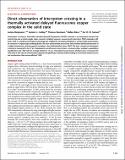Files in this item
Direct observation of intersystem crossing in a thermally activated delayed fluorescence copper complex in the solid state
Item metadata
| dc.contributor.author | Bergmann, Larissa | |
| dc.contributor.author | Hedley, Gordon James | |
| dc.contributor.author | Baumann, Thomas | |
| dc.contributor.author | Braese, Stefan | |
| dc.contributor.author | Samuel, Ifor David William | |
| dc.date.accessioned | 2016-02-01T11:10:04Z | |
| dc.date.available | 2016-02-01T11:10:04Z | |
| dc.date.issued | 2016-01-01 | |
| dc.identifier | 228962038 | |
| dc.identifier | 836e417e-9afd-47b5-9bfb-92b9406c0fae | |
| dc.identifier | 85003972520 | |
| dc.identifier | 000376972900007 | |
| dc.identifier.citation | Bergmann , L , Hedley , G J , Baumann , T , Braese , S & Samuel , I D W 2016 , ' Direct observation of intersystem crossing in a thermally activated delayed fluorescence copper complex in the solid state ' , Science Advances , vol. 2 , no. 1 , e1500889 . https://doi.org/10.1126/sciadv.1500889 | en |
| dc.identifier.issn | 2375-2548 | |
| dc.identifier.uri | https://hdl.handle.net/10023/8105 | |
| dc.description | The authors are grateful to CYNORA GmbH for financial support. This work was supported by the Engineering and Physical Sciences Research Council (grant number EP/J009016/1) and by the European Union Seventh Framework Programme under grant agreement 321305. | en |
| dc.description.abstract | Intersystem crossing in thermally activated delayed fluorescence (TADF) materials is an important process that controls the rate at which singlet states convert to triplets; however, measuring this directly in TADF materials is difficult. TADF is a significant emerging technology that enables the harvesting of triplets as well as singlet excited states for emission in organic light emitting diodes. We have observed the picosecond time-resolved photoluminescence of a highly luminescent, neutral copper(I) complex in the solid state that shows TADF. The time constant of intersystem crossing is measured to be 27 picoseconds. Subsequent overall reverse intersystem crossing is slow, leading to population equilibration and TADF with an average lifetime of 11.5 microseconds. These first measurements of intersystem crossing in the solid state in this class of mononuclear copper(I) complexes give a better understanding of the excited-state processes and mechanisms that ensure efficient TADF. | |
| dc.format.extent | 7 | |
| dc.format.extent | 564771 | |
| dc.language.iso | eng | |
| dc.relation.ispartof | Science Advances | en |
| dc.subject | Thermally-activated delayed fluorescence | en |
| dc.subject | Organic light-emitting diode | en |
| dc.subject | Copper complex | en |
| dc.subject | Intersystem crossing | en |
| dc.subject | Time-resolved photoluminescence | en |
| dc.subject | QC Physics | en |
| dc.subject | DAS | en |
| dc.subject | BDC | en |
| dc.subject | R2C | en |
| dc.subject.lcc | QC | en |
| dc.title | Direct observation of intersystem crossing in a thermally activated delayed fluorescence copper complex in the solid state | en |
| dc.type | Journal article | en |
| dc.contributor.sponsor | EPSRC | en |
| dc.contributor.sponsor | European Research Council | en |
| dc.contributor.institution | University of St Andrews. School of Physics and Astronomy | en |
| dc.contributor.institution | University of St Andrews. Condensed Matter Physics | en |
| dc.identifier.doi | https://doi.org/10.1126/sciadv.1500889 | |
| dc.description.status | Peer reviewed | en |
| dc.identifier.grantnumber | N/A | en |
| dc.identifier.grantnumber | en |
This item appears in the following Collection(s)
Items in the St Andrews Research Repository are protected by copyright, with all rights reserved, unless otherwise indicated.

